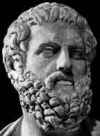Wednesday, 13 December 2006
Turquoise mosaic of a double-headed serpent
Subscribe to:
Post Comments (Atom)
Contents of the day
Article of the Day
  The Mystery of Skeleton LakeAn uninhabited area located high in the Indian Himalayas, Roopkund is best known as the home of Skeleton Lake, where in 1942 a park ranger made a startling discovery—a mass grave containing the remains of some 300 to 600 people. Using radiocarbon dating, scientists traced the skeletons to the 9th century. Though people initially believed the dead were victims of landslides, an epidemic, or a blizzard, further examination of the skulls revealed that the people died in what unusual way? More... Discuss |
Article of the Day
provided by The Free Dictionary
This Day in History
  Sidney Poitier Becomes the First African American to Win Best Actor Oscar (1964)The first African American to achieve leading man status in Hollywood, Poitier began acting with the American Negro Theatre in New York City and made his film debut soon after. He won acclaim on Broadway for his role in 1959's A Raisin in the Sun and, in 1964, became the first African American to win the Academy Award for Best Actor, for his role in Lilies of the Field. Many of his films address issues of race, yet some have criticized his choice of film roles for what reason? More... Discuss |
This Day in History
provided by The Free Dictionary
Today's Birthday
  Lanford Wilson (1937)One of the founders of the "off-off-Broadway" theater movement, Wilson began writing plays in 1962 and helped found the Circle Repertory Company in 1969. His plays frequently address themes of decay, solitude, and loss, and are known for their realistic dialogue in which monologue, conversation, and direct audience address overlap. His Pulitzer Prize-winning Talley's Folly depicts the post-Vietnam War world of a Southern family. What Russian work did he translate for the stage? More... Discuss |
Today's Birthday
provided by The Free Dictionary
In the News
habit-forming discuss | |
| Definition: | (adjective) Capable of leading to physiological or psychological dependence. |
| Synonyms: | addictive |
| Usage: | Cocaine is a habit-forming drug. |
In the News
provided by The Free Dictionary
Quote of the Day
Quote of the Day
provided by The Free Library

No comments:
Post a Comment